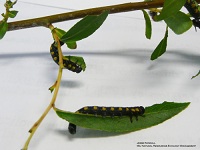Nematus oligospilus
Hosts
Willow and poplar
Appearance and Life Cycle

The willow sawfly is able to complete two generations per year in the southern prairies. First generation adults emerge in mid-May. The adults resemble small wasps, measuring 6-9 millimetres (mm) in length. Almost immediately after emerging and mating, the females place their eggs into pockets that are cut into the leaf tissue from the underside of the leaves. The young larvae emerge within a week and feed on the foliage for just over a month. The larvae are black in color with a roll of large yellow spots along each side. In late June, the full grown larvae measuring approximately 16 mm in length, enter the topsoil beneath the hosts to pupate. Second generation larvae are present from mid-July throughout most of August. When feeding is complete the larvae enter the topsoil beneath the host where they over-winter in cocoons.
Damage

Photo credit: Bob Moul, pbase.com
The newly hatched larvae feeding group, eat only small holes in the leaves at first. Later the larvae feed individually, devouring entire leaves. They are vigorous defoliators and can cause complete defoliation of young or ornamental trees.
Control
Control of the willow sawfly on a few small ornamental trees can be achieved by picking off and destroying the larvae when they are first noticed. For shelterbelts or large trees, chemical control may be achieved with carbaryl, diazinon or malathion.